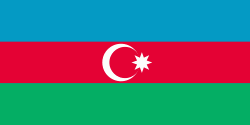Hasanriz (Aterk)
Haterk (Հաթերք) or Hasanriz (Həsənriz) is a village de facto in the Martakert Province of the breakaway Republic of Artsakh, de jure in the Kalbajar District of Azerbaijan, in the disputed region of Nagorno-Karabakh. The village has an ethnic Armenian-majority population, and also had an Armenian majority in 1989.
After the Battle of Manzikert in 1071, the Seljuks conquered most of the remnants of Bagratid Armenia, which had been largely annexed by the Byzantine Empire in the 11th century. The Syunik, Khachen (Artsakh) and Tashir principalities remained unconquered however. The Syunik and Khachen principalities had close ties, their royal families intermarried, and their respective principalities functioned as refuges and bastions for each other during times of need. During the end of the 12th century, Seljuk power declined, and forces of the Georgian-Armenian Zakarian princes moved southwards and established Zakarid Armenia. During this period, the Armenian principalities of the region consisted of the three branches of Khachen: Tsar, Haterk and Khokhanaberd (with their spiritual center at Gandzasar) along with the Khaghbakian family in northern Syunik (Vayots Dzor). The Armenian princes of Haterk (Upper Khachen) were established on the left bank of the Tartar River, with their spiritual center being at Dadivank, the principal church of which was established by Arzu-Khatun, the wife of Vakhtang of Haterk. Prince Hasan of Haterk left an inscription at Dadivank in 1182. The leading family among the three Khachen princes was the one from Haterk. Vakhtang of Haterk contributed in 1191 to the building of the Nor Getik monastery (present day Goshavank in northeastern Armenia). In the 15th century, Artsakh was subjugated by the Turkmen tribes of Qara Qoyunlu and Aq Qoyunlu, and Haterk was destroyed. Its inhabitants founded the modern village close to the original settlement in the 16th century. In 1603, the Persians established a protectorate over the Melikdoms of Karabakh and sponsored the establishment of a local khanate in 1750.
During the Soviet period, Haterk was a part of the Mardakert District in the Nagorno-Karabakh Autonomous Oblast of the Azerbaijan SSR. Haterk came under the control of Armenian forces during the First Nagorno-Karabakh War and subsequently became part of the Martakert Province of the Republic of Artsakh. After the 2020 Nagorno-Karabakh war, 157 displaced people settled in the village.
After the Battle of Manzikert in 1071, the Seljuks conquered most of the remnants of Bagratid Armenia, which had been largely annexed by the Byzantine Empire in the 11th century. The Syunik, Khachen (Artsakh) and Tashir principalities remained unconquered however. The Syunik and Khachen principalities had close ties, their royal families intermarried, and their respective principalities functioned as refuges and bastions for each other during times of need. During the end of the 12th century, Seljuk power declined, and forces of the Georgian-Armenian Zakarian princes moved southwards and established Zakarid Armenia. During this period, the Armenian principalities of the region consisted of the three branches of Khachen: Tsar, Haterk and Khokhanaberd (with their spiritual center at Gandzasar) along with the Khaghbakian family in northern Syunik (Vayots Dzor). The Armenian princes of Haterk (Upper Khachen) were established on the left bank of the Tartar River, with their spiritual center being at Dadivank, the principal church of which was established by Arzu-Khatun, the wife of Vakhtang of Haterk. Prince Hasan of Haterk left an inscription at Dadivank in 1182. The leading family among the three Khachen princes was the one from Haterk. Vakhtang of Haterk contributed in 1191 to the building of the Nor Getik monastery (present day Goshavank in northeastern Armenia). In the 15th century, Artsakh was subjugated by the Turkmen tribes of Qara Qoyunlu and Aq Qoyunlu, and Haterk was destroyed. Its inhabitants founded the modern village close to the original settlement in the 16th century. In 1603, the Persians established a protectorate over the Melikdoms of Karabakh and sponsored the establishment of a local khanate in 1750.
During the Soviet period, Haterk was a part of the Mardakert District in the Nagorno-Karabakh Autonomous Oblast of the Azerbaijan SSR. Haterk came under the control of Armenian forces during the First Nagorno-Karabakh War and subsequently became part of the Martakert Province of the Republic of Artsakh. After the 2020 Nagorno-Karabakh war, 157 displaced people settled in the village.
Map - Hasanriz (Aterk)
Map
Country - Azerbaijan
 |
 |
| Flag of Azerbaijan | |
The Azerbaijan Democratic Republic proclaimed its independence from the Transcaucasian Democratic Federative Republic in 1918 and became the first secular democratic Muslim-majority state. In 1920, the country was incorporated into the Soviet Union as the Azerbaijan SSR. The modern Republic of Azerbaijan proclaimed its independence on 30 August 1991, shortly before the dissolution of the Soviet Union in the same year. In September 1991, the ethnic Armenian majority of the Nagorno-Karabakh region formed the self-proclaimed Republic of Artsakh. The region and seven surrounding districts are internationally recognized as part of Azerbaijan pending a solution to the status of the Nagorno-Karabakh through negotiations facilitated by the OSCE, although became de facto independent with the end of the First Nagorno-Karabakh War in 1994. Following the Second Nagorno-Karabakh War in 2020, the seven districts and parts of Nagorno-Karabakh were returned to Azerbaijani control.
Currency / Language
| ISO | Currency | Symbol | Significant figures |
|---|---|---|---|
| AZN | Azerbaijani manat | ₼ | 2 |
| ISO | Language |
|---|---|
| HY | Armenian language |
| AZ | Azerbaijani language |
| RU | Russian language |















